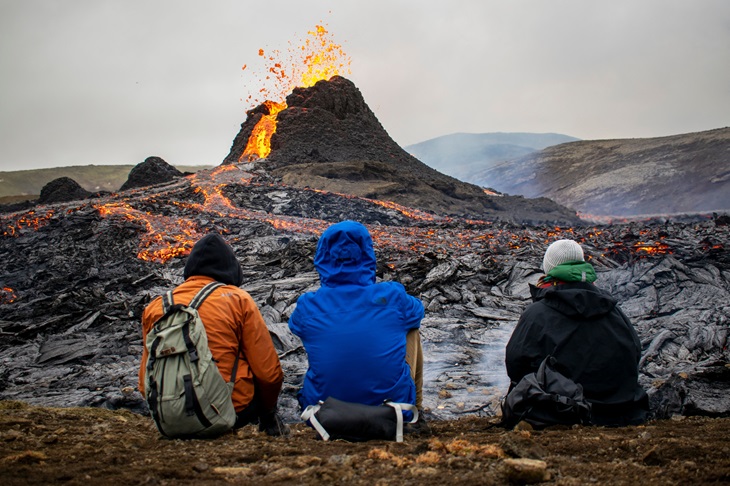Those who think we can control the power of nature are deluded.
The latest threat comes from Iceland. After a sleep of 800 years, the Fagradalsfjell volcano area has been rumbling for 2 years, resulting in the evacuation of 3,500 from the nearest town of Grindavik. It is now erupting.
Iceland has 33 active volcanoes, but the site of this eruption has the potential to threaten the capital and the island’s Airport. The last major eruption in Iceland, in 2010, threw so much ash into the sky that plane flights in the Northern Hemisphere were grounded for days.
For those who have experienced it, being ‘up close up and personal’ with a volcano is an unforgettable experience. A visit to the crater of Mount Yasur, on Tanna Island, Vanuatu, where I am holidaying, reveals their raw power. There are explosions of noise as molten lava is shot into the air. It is joined by the acrid smell of sulphur and even the ground shakes underfoot. Their fury can be felt at far away, even affecting distant weather.
A volcano is a vent in the Earth’s crust which allows energy to escape from the molten inner core. Apart from lava, eruptions also release volcanic dust and huge amounts of sulphur dioxide (SO2) and carbon dioxide (CO2). Underwater eruptions put large amounts of water high into the atmosphere. These outputs can remain at altitude for months, even years. Modelling disputes the amount of CO2 released, as to whether these eruptions increase temperature (with CO2), or reduce temperature by blocking the sun’s rays (with water vapour and dust). Sulphur dioxide, apart from locally causing acid rain, is converted to aerosols which reflect sunlight and also contributes to cooling.
Volcanoes are described as active (erupting in recent years), dormant (erupted in the distant past, but capable of further events), or extinct. There are around 1,500 active volcanoes worldwide, 50-70 erupt each year. There are an estimated 170 in US, the most recent activity being at Mount St Helens, 82 are in Europe, with 32 of those in Iceland. The only active volcano in Australia is on Heard Island, 4,000 km south-west of Perth. The last eruption on the Australian continent was 5,000 years ago, at Mount Gambier, this makes it a dormant volcano, not extinct.
Neighbouring New Zealand is on the ‘Ring of Fire’, an extensive fault line, where tectonic plates meet, the country has 9 active volcanoes and regular earthquakes. The country’s last eruption was on White Island, 48 km off the mainland. It was an event that, in 2019, killed 21 tourists. These fault lines release thermal energy which can be harnessed for electricity generation, as in New Zealand and in Iceland. These energy sources also release large amounts of CO2, in Iceland around 300,000 tonnes of CO2 daily, equivalent to a quarter of Australia’s total emissions.
Following a recent event a month ago, a new island appeared in the Ogasawara group, off Japan. The biggest volcano in the world, (so far, it was only discovered in 2013), is the subsea Tamu Massif, at 4 km high and 640 km wide, it also lies East of Japan.
The subsea Hunga Volcano near Tonga, is the biggest eruption of the 21st Century; it began in late 2021 and continued for 2 months, releasing gas and dust into the atmosphere.
There was an initial, much-publicised, minor temperature increase in the Southern Hemisphere, followed by a more prolonged (and ignored by the media) decrease, due to vast amounts of atmospheric water vapour and dust.
Resulting tsunamis reached as far as Fiji, Samoa, Vanuatu, and was detected in places as remote as the Americas. Locally, waves were up to 45 metres high (on Tonga’s Tofua Island). There was major damage to Nuku’alofa, the capital, but fortunately few lives were lost.
Subsequently, this led to the formation of tropical cyclone Dovi, and record heavy rainfall events in Eastern Australia and New Zealand.
The relationship between volcanic eruptions and climate has been the source of much controversy, but there is little doubt that major events have had significant effects, both locally and afar. The 1815 eruption of Mount Tambora, in Indonesia, made little initial impact in Europe, as the military activities of Emperor Napoleon were of greater concern at the time. Locally, the death toll was put at 250,000.
The eruption released massive amounts of dust, rock, and SO2, affecting climate throughout the Northern Hemisphere. The temperature dropped by over 1 degree C, for over a year, resulting in crop failures and increasing sea ice.
The year 1815 was known as the year with no Summer, but, as shown below, it took several years for the complete temperature recovery.
Tambora eruption and world temperature Krakatoa, also in Indonesia, in 1883 was the site of the second largest eruption in modern times, resulting in 30,000 deaths. It reduced the Northern Hemisphere temperature by 0.6 degrees C and the volcanic dust thrown into the atmosphere reputedly turned the moon blue for a year.
Mount Pinatubo, in the Philippines, was the second largest in the 20th Century, it resulted in release of 20 million tons of sulphur dioxide, resulting in a temperature fall of 0.5 degrees C for 2 years.
Recent volcanic eruptions, on a scale of 0 to 8 measure volcanic explosive activity (VEI), number 8 is classified as a super volcano. The biggest recorded, as above, was La Garita which erupted in the US 35 million years ago with a force estimated at 10,000 times that of Mount St Helens.
More recent historical events may have also had effects on our climate. In the mid-1600s there were a series of major volcanic eruptions in Japan, Chile and the Philippines. Later in that century there were yet more major events, 3 in Japan, 2 in Indonesia, and 1 in New Guinea. These events occurred around the time of the ‘Little Ice Age’, when the temperatures dropped for around 200 years, reaching a minimum around 1700. This period resulted in widespread famine and disease.
Temperatures have been rising since the 1700s (preceding industrialisation and increased CO2 levels), and have now reached the same as 1,000 years ago, in the Medieval Warming period.
This series of major eruptions could have contributed to the world cooling. A more likely explanation for this temperature change was a fall in solar activity, and variation in the Earth’s orbit. We are living in a relatively quiet period for volcanic activity but, should any of the known super-volcanoes – in the US, Sumatra, New Zealand, or Japan erupt, the climatic consequences are certain.
In recent years, major events have been more limited in scale. Mount St Helens, in Washington USA, was in 1980, the site of the biggest explosion in many years in North America. Gas and dust reached a height of 26 km, 54 were killed, and darkness descended as far as 400 km away. Minor events continued for the next 15 years.
Europe has not been immune to activity, with the Etna and Vesuvius volcanoes still active. In the past, there have been major eruptions including Thera, near Crete, erupting around 4,000 years ago which spread ash as far away as Egypt. Of greater concern is the giant subsea volcano, Marsili, off the foot of Italy, rising to 3000 meters and still active. The Axial Seamount volcano is 500 km off the coast of Oregon, USA. At 1,400 meters this submarine volcano is not the biggest, but it is very active, with eruptions in 2011 and 2015. It is the subject of much research into how these hidden volcanoes function.
Problems on the other side of the world are less apparent, as the fault line is primarily hidden under the sea, as above, with few land effects. Estimates of the number of subsea volcanoes vary widely, up to a million, only a quarter of the under-sea surface has been mapped. US submarines have sometimes found them the hard way, twice colliding with volcanoes, in 2005 and 2021.
The climatic significance of these features is unknown, most are extinct but it is estimated that 80 per cent of volcanic activity occurs under the sea. Recently, the Icelandic fault line has been active, only 35 km from the capital, Reykjavik, with earthquakes and lava flows. A major eruption is threatening, with evacuations of closer communities carried out. Iceland straddles the mid-Atlantic Ridge, a crack in the ocean floor between the Eurasian and North American tectonic plates.
Other volcanoes of significant concern are in the Antarctic. There are several active volcanoes on land, but subsea mapping (as below) of some adjacent Antarctic areas in 2011, revealed around a dozen unknown subsea volcanoes, the biggest challenging for the record at around 4,000 metres height. By 2017, the number newly-discovered had increased to 91. There is unease over their increasing activity and the potential effect on ice shelves, some up to 4 km thick, on the surface above. A mantle plume of heat, upwelling from a depth of 2,300km was discovered in West Antarctica in 2017. This increased heat, three times the background level, feeds several volcanoes and appears responsible for the retreat of glaciers.
By measuring helium isotope levels, scientists can extrapolate to the degree of volcanic activity, levels which equate to 60 per cent of Iceland’s current active volcano.
Should the West Antarctic ice sheet collapse, the sea could rise by an estimated 5 metres, putting as many as 100 million people at risk. A collapse of the Thwaites glacier, nicknamed the doomsday glacier, could on its own raise levels by 70 cms. At the opposite pole, forecasts of Arctic ice disappearing have not eventuated, and should it melt, there would be minimal effect on sea levels.
Fortunately, Greenland, the other massive reservoir of ice, unlike its neighbour Iceland, has no active volcanoes.
Big eruptions in the distant past have caused mass extinctions. An eruption 250 million years ago in Siberia wiped out most life on Earth, with CO2 levels increasing from 400 to around 2500 ppm. A more recent event, a mere 73,000 years ago in Indonesia, dropped the planet’s temperature for around 10 years, nearly wiping out humanity; it left so few survivors that future genetic diversity was believed affected.
None of these events, like many other natural phenomena, are included in climate computer models, models which have already demonstrated their inaccuracy, but are portrayed as gospel. Perhaps, despite the world supposedly ‘boiling’ with the ‘highest temperature in 125,000 years’, a major volcanic event could cause another scenario, with catastrophic flooding, even life-destroying temperature reductions?
Got something to add? Join the discussion and comment below.
Get 10 issues for just $10
Subscribe to The Spectator Australia today for the next 10 magazine issues, plus full online access, for just $10.


























Comments
Don't miss out
Join the conversation with other Spectator Australia readers. Subscribe to leave a comment.
SUBSCRIBEAlready a subscriber? Log in